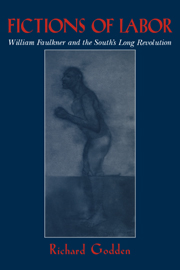Book contents
- Frontmatter
- Contents
- Acknowledgments
- Introduction
- 1 Quentin Compson: Tyrrhenian Vase or Crucible of Race?
- 2 Absalom, Absalom!, Haiti, and Labor History: Reading Unreadable Revolutions
- 3 Absalom, Absalom! and Rosa Coldfield: Or, “What Is in the Dark House?”
- 4 The Persistence of Thomas Sutpen: Absalom, Absalom!, Time, and Labor Discipline
- 5 Forget Jerusalem, Go to Hollywood – “To Die. Yes. To Die?” (A Coda to Absalom, Absalom!)
- Afterword
- Notes
- Bibliography of Works Cited
- Index
- Titles in the Series
3 - Absalom, Absalom! and Rosa Coldfield: Or, “What Is in the Dark House?”
Published online by Cambridge University Press: 04 December 2009
- Frontmatter
- Contents
- Acknowledgments
- Introduction
- 1 Quentin Compson: Tyrrhenian Vase or Crucible of Race?
- 2 Absalom, Absalom!, Haiti, and Labor History: Reading Unreadable Revolutions
- 3 Absalom, Absalom! and Rosa Coldfield: Or, “What Is in the Dark House?”
- 4 The Persistence of Thomas Sutpen: Absalom, Absalom!, Time, and Labor Discipline
- 5 Forget Jerusalem, Go to Hollywood – “To Die. Yes. To Die?” (A Coda to Absalom, Absalom!)
- Afterword
- Notes
- Bibliography of Works Cited
- Index
- Titles in the Series
Summary
In 1865 Henry Sutpen shoots Charles Bon dead at the gate to Sutpen's Hundred. In 1909 Rosa Coldfield tells Quentin Compson what she knows of that death and the events that follow it. I offer the dates merely to indicate that Rosa has had forty-four years in which to get her story straight and yet remains capable of statements such as, “for had I not heired too from all the unsistered Eves since the Snake?” and “I became all polymath love's androgynous advocate” (p. 117). Whether or not one deems her phrasing poetically dense (apt perhaps in an elegist) or transgressive (“a challenge to what we might call the paternal phallic authority of a text's meaning”), the upshot is mystification.
Rosa has nominal grounds for obscurity; before breaking into the Hundred in 1909 and talking to Henry, she apparently does not know who the murder victim is, beyond his being Henry's university friend and Judith's suitor. However, as Eric Sundquist persuasively argues, when she enters the Hundred to confront the corpse, she appears possessed of a covert account of Bon's identity. Faced with Clytie, blocking her way to the stairs and to the body in Judith's bedroom, Rosa “crie[s]”, “And you too? And you too, sister, sister?” (p. 112). Since she specifically does not address the term “sister” to Judith (“and not to Judith, mind”) but to Clytie, and to Clytie's face, “which was at once both more and less than Sutpen” (p. 112), it follows that Rosa recognizes Clytie as sharing a sister's relation to Bon.
- Type
- Chapter
- Information
- Fictions of LaborWilliam Faulkner and the South's Long Revolution, pp. 80 - 114Publisher: Cambridge University PressPrint publication year: 1997

